 A bright, 3rd mag. comet announced! check more below!
A bright, 3rd mag. comet announced! check more below!
still need the previous edition?
 A bright, 3rd mag. comet announced! check more below!
A bright, 3rd mag. comet announced! check more below!
![]() .Events .Moon .Planets .Minor Planets, NEOs .Comets .Shooting Stars .Occultations .Sun .check more! (occultations observers are advised to check in 'Events', and to turn to such dedicated sites like the I.O.T.A). don't forget to check the weather! For the US: the NOAA . color codes: Wwd worldwide, UsA USA-Americas, EuA Europe-Africa, AsP Asia-Pacific, Chk Check for Your Zone. check the site's concept and the instructions of use
.Events .Moon .Planets .Minor Planets, NEOs .Comets .Shooting Stars .Occultations .Sun .check more! (occultations observers are advised to check in 'Events', and to turn to such dedicated sites like the I.O.T.A). don't forget to check the weather! For the US: the NOAA . color codes: Wwd worldwide, UsA USA-Americas, EuA Europe-Africa, AsP Asia-Pacific, Chk Check for Your Zone. check the site's concept and the instructions of use
![]()
![]() Editor's
Choice Fine Picture Archives
Editor's
Choice Fine Picture Archives ![]() Editor's Choice Sky At
Editor's Choice Sky At ![]()
![]()
![]() Tech News
Tech News ![]() color codes: Wwd worldwide, UsA USA-Americas, EuA Europe-Africa, AsP Asia-Pacific, Chk Check for Your Zone. check the site's concept and the instructions of use
color codes: Wwd worldwide, UsA USA-Americas, EuA Europe-Africa, AsP Asia-Pacific, Chk Check for Your Zone. check the site's concept and the instructions of use
| Tweet |
.Events Seen All Month Long .Ephemerides Proper
(data from the former yearly ephemerides generator at Fred Espenak's NASA's eclipse website; miscellaneous data with the 'Astronomical Phenomena for The Year 2017,' a joint work by the United Kingdom Hydrographic Office and the U.S. Naval Observatory; to be found at the latter's site; all time UT except otherwise stated)
Wwd The three stars of the Summer Triangle, that distinctive feature of the skies by summer, are seen, in the northern hemisphere only, like high evening stars West. Fine views! Also of interest is that Vega and Deneb, two of those three stars, are reappearing with dawn, like morning stars, northeast!
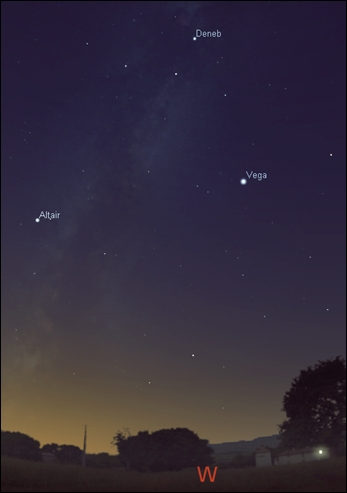 | The Summer Triangle, in the northern hemisphere, is seen by twilight! picture site 'Amateur Astronomy' based upon Stellarium |
Wwd A set of fine constellations embedded into the Milky Way is seen South by dawn at the Tropics. Fine views!
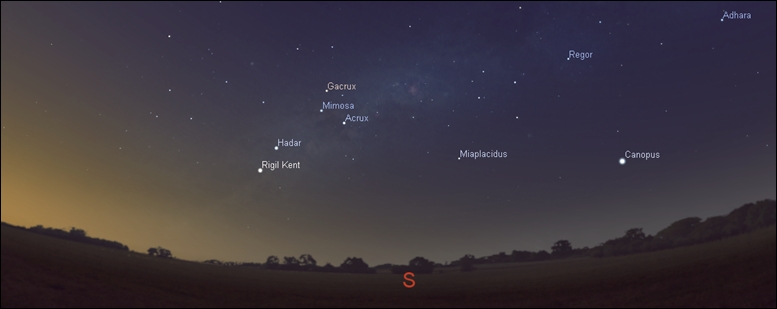 | Fine constellations are seen South, by dawn, at the Tropics, embedded into the Milky Way! picture site 'Amateur Astronomy' based upon Stellarium |
2 UsA Tomorrow morning, last crescent, at all latitudes, is seen close to Venus with Spica, the bright star to constellation Virgo, the Virgin not that far. A fine show worth the visual and photographic observation!
3 EuA AsP Tomorrow morning, last crescent, by all latitudes, is seen close to Venus with Spica, the bright star to constellation Virgo, the Virgin not that far. A fine show worth the visual and photographic observation!
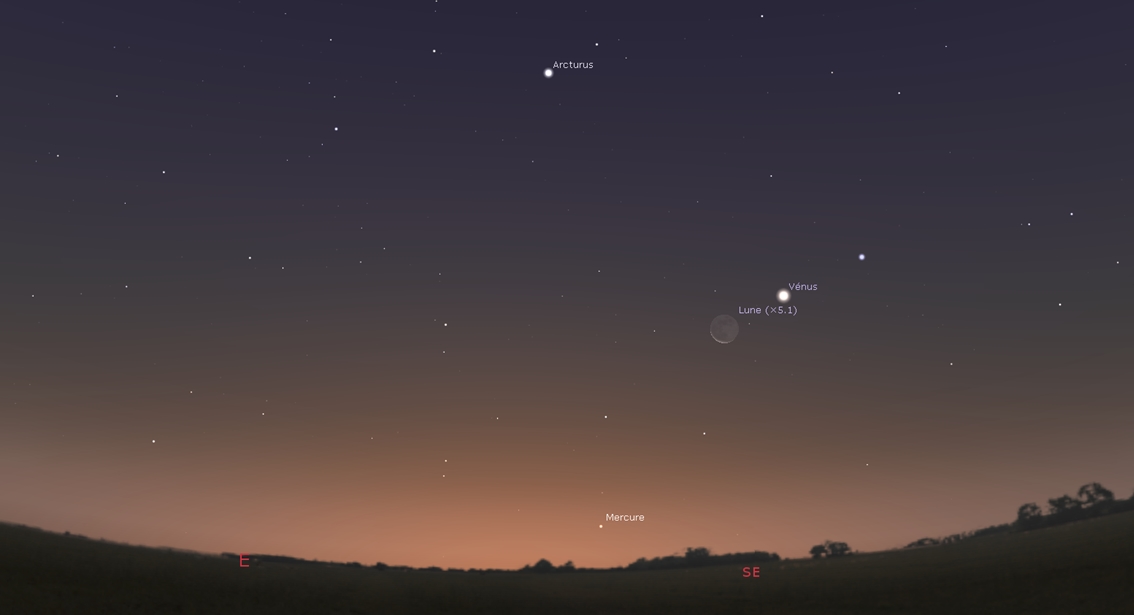 | Moon close to Venus in the morning sky! picture site 'Amateur Astronomy' based upon Stellarium |
Wwd 7 The Geminids, one among the most active shooting stars showers in the year, usually begin to be active today as they are until next Dec. 17. They usually are peaking on Dec. 13-14 more at the date of the peak
9 (1) Wwd There is a occultation of Saturn today by Moon! check more at Occultations; check more too at such sites like "The International Occultation Timing Association" (I.O.T.A.)
9 (2) Wwd Moon reaches a southernmost declination at 11:12 UT
10 (1) Wwd There is a occultation of Pluto, that faraway world, today by Moon! check more at Occultations; check more too at such sites like "The International Occultation Timing Association" (I.O.T.A.)
10 (2) Wwd Moon is at a descending node at 17:57 UT
12 Wwd Moon is at its apogee at 12:25 UT (distances non available)
13 Wwd The Geminids usually are peaking on Dec. 13-14 more back
14 UsA EuA First quartered Moon, at all latitudes, close to Mars!
15 AsP First Quarter, by all latitudes, close to Mars!
20 UsA EuA Waxing gibbous Moon tonight, by all latitudes, is close to Aldebaran, the bright star to constellation Taurus, the Bull
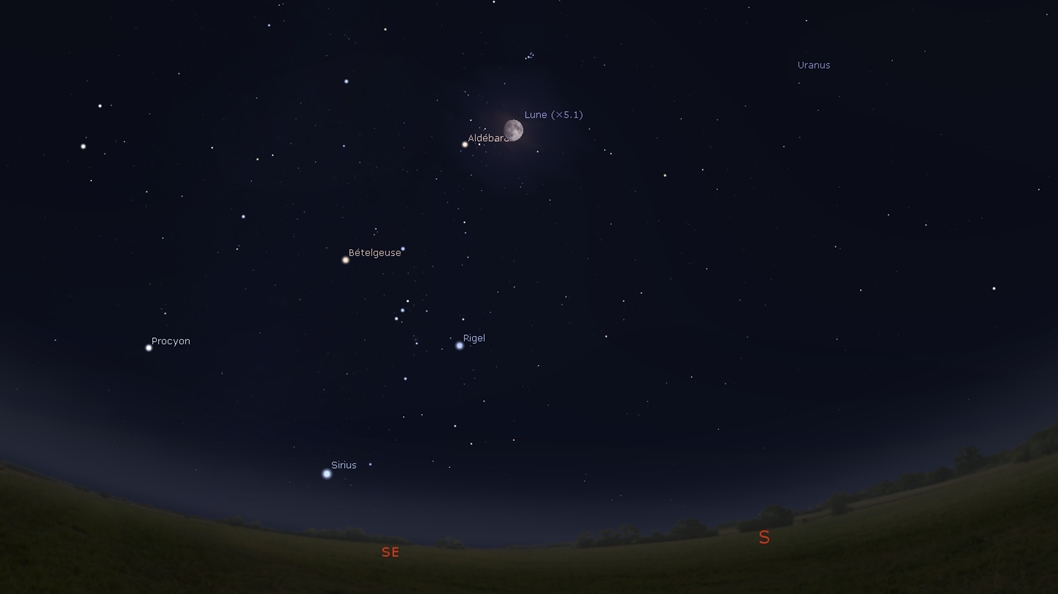 | Waxing gibbous Moon close to Aldebaran, the bright star to Taurus, the Bull. picture site 'Amateur Astronomy' based upon Stellarium |
21 (1) Wwd It is the winter solstice today, by 22:22. It's winter North, and summer South! check more details about Earth's seasons with our tutorial Seasons
21 (2) AsP Waxing gibbous Moon tonight, at all latitudes, is close to Aldebaran, the bright star to constellation Taurus, the Bull
23 Wwd Moon reaches a northernmost declination at 11:48 UT
24 Wwd Moon is at at its perigee at 09:52 UT (distances non available) as the same day it is at a ascending node at 11:54 UT
New Moon is on December 7th, at 07:20 UT
First Quarter is on December 15th, at 11:49 UT
Full Moon is on December 22nd, at 17:49 UT
Last Quarter is on December 29th, at 09:34 UT
(source: ephemeris generator at Fred Espenak's NASA's eclipse website)
Mercury is reaching a greatest western elongation on Dec. 15 by 10:59 UT. Mercury, like a morning star, is rising above the horizon during December. The show is eventually low in the northern hemisphere, or the southern, as it is mean at the Tropics. check more about such a configuration of a planet in our tutorial 'Planets Apparent Motion'
Venus, which reappeared like a morning star since early November, has now turned a high morning star worldwide
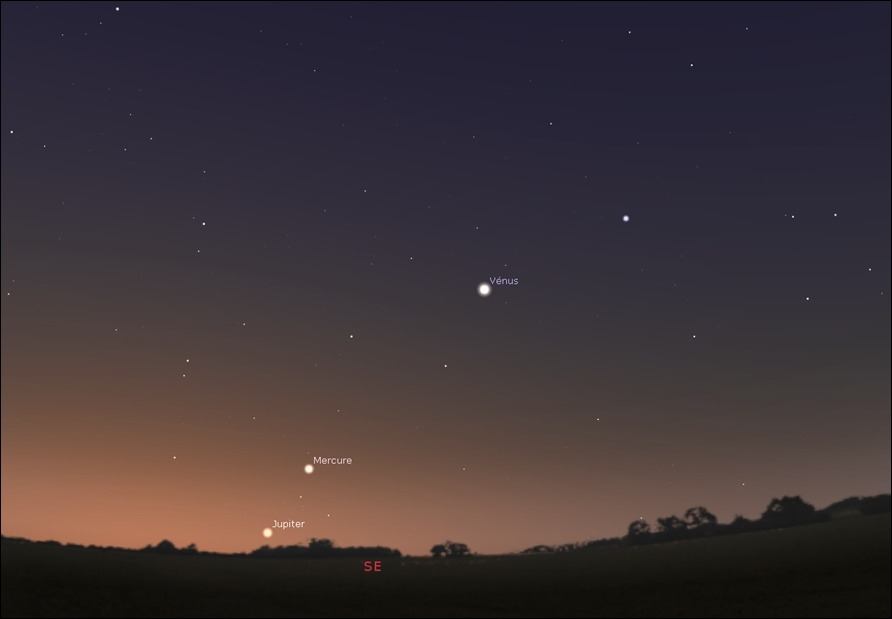 | Venus a fine evening star worldwide! picture site 'Amateur Astronomy' based upon Stellarium |
Mars Mars Observation Campaign! keeps observable southwest in the northern hemisphere, more West at the Tropics or the southern hemisphere. A Mars Observation Campaign is unfolding 2018-2019 as it constitutes a remarkable, perihelic opposition, with Mars nearest to Earth at the same time it is nearest to the Sun on its orbit! Mars will reach a 24.2" of apparent diameter at its best as the observation campaign will span from when the Red Planet is reaching, then leaving 6" of apparent diameter! Don't miss those occasions of observing Mars! check more at our Mars Observation Campaign 2018-2019 page
Jupiter which had reached its yearly conjunction last November 26th, is not really reappearing like a morning star in the northern hemisphere, or the southern. It is somewhat higher at the Tropics
Saturn will reach its yearly conjunction next January 2nd, 2019. It's now unobservable in the northern hemisphere or the southern, as barely a evening star at the Tropics. A ring maximum aperture had been reached in 2017
Uranus is high now, southwest, by 10:30 p.m. local time in the northern hemisphere, as it is high past West at the Tropics, or high and tending North in the southern hemisphere
Neptune is still observable in the northern hemisphere about southwest, or West at the Tropics. Neptune is the southern hemisphere is also observable, past West, but later due to a late twilight
Pluto is no more observable worldwide. Pluto in 2018 is reaching a rare 'special' opposition as the latter will occur because the planet will reach its orbit's line of node. (according to the International Astronomical Union (IAU) since 2006, Pluto is not considered a planet anymore, but categorized like a dwarf planet instead along with Ceres, Eris, Makemake, and Haumea, and the prototype of a new category of 'trans-Neptunian', 'Pluto-class' objects)
Minor planets are those biggest asteroids in the Asteroid Belt which may be easily observed by amateurs from the Earth, namely Ceres, Pallas, Juno, and Vesta (due to the new categorization by the International Astronomical Union (IAU) by 2006, Ceres belongs to the 5 dwarf planets in the solar system with Pluto, Eris, Makemake, and Haumea). check data and charts at our section Minor Planets on the yearly Calendar page as our tutorial 'Asteroids and Asteroid Hunting' is of help too. Any remarkable event linked to a minor planet may have a notice here below
Some small asteroids dubbed Near-Earth Objects (NEOs) are regularly making close approaches at Earth. People interested in such close approaches may obtain recent and upcoming data at NASA site Near-Earth Object Program (their section "Close Approaches"). Date, miss distance in AU or Lunar Distance (LD), estimated diameter, and relative velocity are available. For further observational purposes, check at the Near-Earth Object Program ephemeris Generator. For more about NEOs see tutorial "
Once every time, the solar system treats us with a remarkable comet, a eery view spanning up to thirty degrees of sky! Most of the time however comets are the domain of dedicated observers as mostly weak and, at the most, hovering at the limit of the naked-eye visibility. A good site to get information about current such comets is the British Astronomical Association Comet Section page or also the Weekly Information about Bright Comets page (which often points to comets close to the visual magnitude). Our 'Comets and Comet Hunting' tutorial will also be helpful. Remarkable comets otherwise usually will be presented below!
back ->A Bright Comet Announced!
Sites dedicated to comets are forecasting a bright comet, at about the 3rd magnitude by December 16th, 2018! Comet 46P/Wirtanen was discovered since 1948 as its perihelion was reduced in 1972 and 1984 due to passages at Jupiter. Its closest Earth will be on Dec. 16 making it a naked-eye, or binocular object and will be best observed under dark skies. The reapparition of Moon in the night sky will be a factor too as the comet will be close to the Pleiades. By early December comet 46P/Wirtanen is said at about the 5th magnitude. In terms of observation, comet Wirtanen will be seen worldwide East or northeast and visible as the night will be falling. Fine visual and photographic opportunities! check a chart of the visibility worldwide of comet 46P/Wirtanen on Dec. 16, 2018; click to a chart of comet 46P/Wirtanen' journey during December 2018 (all ticks for 00:00 UT from one day into one day)
The site's webmaster checked for the comet last Dec. 11, 12, and 13 and, like some say, expectations must be kept low because the comet might be much diffuse and not overcome the background luminosity in suburban skies. Unless the Dec. 16 apparition be dramatically better. Comet 46P/Wirtanen interstingly had been first selected like the target to European ESA's cometary Rosetta mission
->note: shooting stars afficionados will be aware of checking Moon at the dates of the showers
for more about the meteor showers of this month, for possible other meteor showers for this month, and for more about shooting stars, generally, see our tutorial "Shooting Stars"
Each month, Moon occults some relatively bright stars, that is the Moon, beginning either with its bright or its dark visible face, is passing in front of a star. This is called an occultation. The Pleiades, on the other hand, due to their position near the eclipic, are often occulted by Moon too. Some planets, at last, along the year, may be occulted by Moon or they themselves, or their satellites, may be seen too occulting a star. The asteroids too may occult stars. Yearly lists of such phenomenons are to be found at Sky & Telescope/SkyTonight.com, either in their newsstand issues or at their site, as a list of occultations of most brilliant stars, the planets and the Pleiades are available at the I.O.T.A site (I.O.T.A. stands for "The International Occultation Timing Association"). Most notable occultations are signaled below
Saturn back is occulted by Moon on Dec. 9th, 2018 by 05:00 UT! The show is available for South eastern Russia, and the northern tip of China . check more at such sites like "The International Occultation Timing Association" (I.O.T.A.)
Pluto back, that faraway world, is occulted by Moon on Dec. 10th, 2018 by 04:00 UT! The show is available for N.E. China, E. Mongolia, Japan, E. and S.E. Russia, N. Micronesia, and the Aleutian Islands. check more at such sites like "The International Occultation Timing Association" (I.O.T.A.)
check on this site for more about occultations, theoretically
| CAUTION! OBSERVING THE SUN IS DANGEROUS AND REQUIRES DEDICATED SAFE TECHNIQUES! |